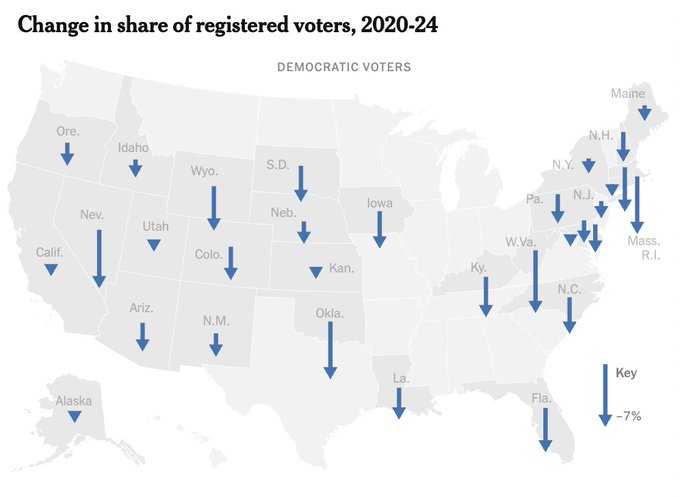


A new Insider Advantage poll finds Trump's approval surging -- except with the oldest voters.
Voters Not So Much
Posted on August 18, 2025
Survey conducted August 15-17; MOE 3.09%
What is your opinion of President Trump's Job Performance?
Approve: 54%
Disapprove: 44%
Undecided/ No Opinion: 2%
Analysis by InsiderAdvantage Pollster Matt Towery:
Donald Trump now has an advantage among every age group other than the most senior of voters. He has improved his numbers among African-Americans and Hispanic-Latinos. White voters are at a near record 64%. Voters under 65 years of age now approve of his job performance by wide margins. Only the nation's oldest voters disapprove of his job performance, which is consistent with our prior surveys. Overall, his approval numbers are surging upwards post-summit.
Meanwhile, the Democrats are losing voters by the millions:
Many blue states, like massive California, register voters by party while many red states, including Texas, do not, so the number of nationwide registered voters by party does not tell the full story. But in those 30 states with partisan voter registration, Democrats' eleven-point edge over Republicans on Election Day 2020 plummeted to just over six points in 2024, an alarming trend for Democrats.
"I don't want to say, 'The death cycle of the Democratic Party,' but there seems to be no end to this," Michael Pruser, director of data science for Decision Desk HQ, told the Times. "There is no silver lining or cavalry coming across the hill. This is month after month, year after year."
More trends paint a similarly dire picture for Democrats.
By 2024, the Republican party's share of new registered voters nationwide "had overtaken Democrats'," rising by nine points compared to 2018, the report details, while Democrats' fell by almost eight percent.
The shift from 2020 to 2024 was prevalent in the four swing states with partisan data available as well -- North Carolina, Pennsylvania, Arizona, and Nevada.
Identifying the problem is likely to be far easier than fixing it.
Due to the makeup of Trump's new Republican Party coalition, achieved through gains across multiple demographics, Democrats are unable to go back to the well of recruitment of racial minorities to reverse their downward trajectory. The Times report reads:
For years, the left has relied on a sprawling network of nonprofits -- which solicit donations from people whose identities they need not disclose -- to register Black, Latino and younger voters. Though the groups are technically nonpartisan, the underlying assumption has been that most new voters registering would vote Democratic.
Mr. Trump upended that calculation with the inroads he made with working-class nonwhite voters.
Shane Goldmacher of the NYT tells Democrats the bad news.
Shane Goldmacher
@ShaneGoldmacher
NEW at NYT: The Democratic Party is facing a voter registration crisis in red, blue and battleground states alike -- losing ground to the GOP everywhere.
My deep dive into the numbers and what it reveals about the party's brand.
30 states plus D.C. allow for partisan registration.
Between 2020 and 2024, Democrats lost 2.1 million voters in those states. GOP gained 2.4 million.
But those topline figures are just the start...
By percentage, Democrats went from nearly an 11-point edge over GOP in 2020 to just over a 6-point edge in 2024.
Along the way, some states have flipped to GOP registration edge entirely.
Florida, of course.
But more big ones are likely coming...
In Pennsylvania, the quintessential battleground, Democrats had registration advantage of 517,310 among active voters in November 2020.
As of this summer: Only 53,303 voters.
In North Carolina, Republicans erased roughly 95 percent of the registration advantage that Democrats held in the fall of 2020 by this summer.
The Dem edge is less than 17,000 -- down from nearly 400,000 in 2020.
Some have dismissed registration as a lagging indicator in the past.
But in 2024 it proved prescient: Democratic weakness was concentrated where Trump was strongest, among men and younger voters.
There are few better measurement's of a party's brand than who actively chooses to identify (and register) with it.
And fewer and fewer voters are choosing to become Democrats.
Check out this graphic of the trendline for new registrants since 2018.
We also have some takeaways on the findings.
This is perhaps the most stark one.
